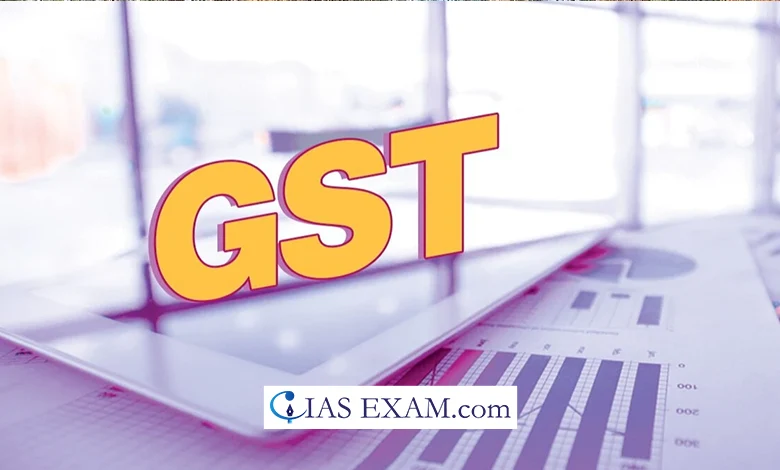Daily Current Affairs for UPSC
Rise in Goods and Services Tax (GST) Revenues
Syllabus- Economy [GS Paper-3]

Context
Revenues from the Goods and Services Tax (GST) crossed the ₹2 lakh crore highest mark for the first time in April.
Key Highlights
- This represents a whole 12.4 percent year-on-year growth, driven through a strong increase in domestic transactions (up 13.4 percent) and imports (up 8.3 percent).
Goods and Services Tax (GST)
- Goods and Services Tax is an indirect tax used in India at the supply of goods and services.
- It is a tax levied on most goods and services offered for domestic consumption.
- It was launched in India in 2017 as a single indirect tax for the whole country.
- It is a comprehensive, multistage, destination based tax–
- Comprehensive because it has subsumed almost all of the indirect taxes except a few state taxes.
- It is paid by the consumers and is remitted to the government by the organizations promoting the goods and services.
- It is of three types i.e.
- CGST to be levied by the Centre,
- SGST to be levied by the States and
- IGST a tax levied on all Inter-State components of goods and/or services.
- All those taxes are levied at rates collectively decided by the Centre and the States.
- The GST Council headed by the Union Finance Minister is the governing and key decision-making frame for GST.
- Recently, the GST reimbursement Act has been enacted which presents a detailed mechanism for reimbursement to the states for loss resulting from implementation of GST.
- For the motive of GST reimbursement to states, a cess called Compensation Cess is being levied on luxury and demerit goods and proceeds of such cess is being credited to a separate Public Account fund referred to as Compensation Fund.
Achievements of GST
- Better Compliance: GST helped in achieving better tax compliance by way of subsuming multiple taxation and reduction in taxation burden in the last four years.
- Automated tax environment: It helped the country in transitioning to an automatic indirect tax environment. From digital compliances, technology of e-invoices to monitoring movement of products through e-waybill – the whole lot is now on-line.
- E-invoice & More Revenue: The E-invoicing system helped lessen fake invoicing. Use of technology with on-line bill technology has resulted in smoother consignment movement and much fewer disputes with officers. After the introduction of E-invoice, GST collections have risen step by step seeing that November 2020, surpassing the Rs. 1 lakh crore mark on numerous occasions.
- Logistical efficiency, manufacturing cost cut: Another most important achievement of this regime is the fact that over 50% of logistics effort and time is stored for the reason that GST has ensured the elimination of more than one checkpoints and allows at nation border checkpoints.
- Lesser transaction prices: After the introduction of GST, there has been a huge reduction in transaction costs. This discount has been a large breakthrough within the interstate motion of products, allowing the country to boast of a single national unified market for companies.
- Cooperative Federalism: The customs portals are related with the GST portal for credit score availing on imports constitution of the GST Council and ensuring Centre-State partnership in the choice-making manner. It ensured cooperative federalism to be its foremost part.
- Ease of doing business: India’s ease of doing business ranking has stepped forward extensively in the last 4 years. Before GST was implemented, India’s Ease of Doing Business ranking changed into 130 in 2016. In 2020, India turned into ranked 63rd at the list.
- More Freedom: Since the GST cost is the same across the country for a specific supply, traders and manufacturers in the organised sectors have won more freedom to pick out the great providers, providers, and different stakeholders with higher pricing, irrespective of their place.
- Improved Competitiveness: GST has progressed the competitiveness of domestic industries in the worldwide market by casting off hidden and embedded taxes.
- Boosting Make in India Initiative: GST will deliver a leading progress to the ‘Make in India’ initiative of the Government of India by making goods and services produced in India competitive inside the National in addition to the International market.
Shortcomings of GST
- Increased compliance burden: GST entails multiple tax returns and may be complex for small and medium-sized enterprises (SMEs) to navigate. This may be specifically difficult for corporations that function in more than one state.
- Higher tax burden for some SMEs: Previously, a few small companies have been exempt from certain taxes. Under GST, the registration threshold is low, bringing more groups into the tax net, that could pressure their assets.
- Software costs: Migrating to a new tax system regularly requires upgrading the accounting software program to be GST-compliant. This can be an additional cost for agencies.
- Impact on the unorganized sector: The unorganized sector, a huge part of the Indian financial system, has faced challenges adapting to GST. Formalizing these businesses can take time.
- GST charges and complexities: The modern-day multi-tier GST shape with diverse tax costs can be complex for corporations to cope with.
- Adoption & Technical Issues: Small and medium corporations are nevertheless grappling to conform to the tech-enabled regime. The fundamental standards on which the GST law turned into constructed viz. Seamless float of enter credit and simplicity of compliance has been impaired through IT system faults,
- Other Concerns: Further, the fifteenth Finance Commission, in its file, has additionally highlighted several areas of difficulty in the GST regime regarding:
- multiplicity of tax costs,
- shortfall in GST collections vis-à-vis the forecast,
- excessive volatility in GST collections,
- inconsistency in filing of returns,
- dependence of States on the compensation from Centre
Reforms Needed
- Simplification of GST compliance: This ought to involve decreasing the variety of tax go back filings, streamlining the return layout, and making the process greater person-pleasant for small groups.
- Reviewing the GST rate structure: There’s discussion about probably:
- Reducing the variety of tax slabs: This could make the gadget less complex for agencies to control.
- Raising the edge for GST registration: This should exempt a few small organizations from GST altogether, decreasing their compliance burden.
- Rationalizing tax quotes: This would possibly involve merging some tax slabs or adjusting fees to ensure a balance between sales collection and affordability for customers.
- Technological answers: Investing in user-friendly technology structures can simplify GST filing and compliance for organizations.
- Addressing the challenges of the unorganized sector: Initiatives to assist casual businesses transition smoothly into the GST system might be beneficial. This may contain imparting schooling and help.
- Improving coordination between Central and State government: Streamlined communication and statistics sharing between union and state GST authorities can enhance efficiency and reduce compliance hassles for agencies working throughout states.
Source: The Indian Express
UPSC Mains Practice Question
Q. Discuss the achievements of GST till now. What are the challenges associated with the implementation of GST.





.png)



